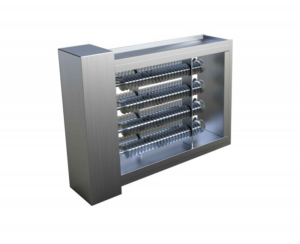Choosing Finned vs. Unfinned Tubular Duct Heaters | Wattco
Last updated on November 2nd, 2022 at 03:20 pm
Finned duct heaters have distinct advantages over unfinned and tubular ones and vice versa. Best of all, they have a wide range of industrial applications, namely, those that require heating. This post will examine these uses and where these devices excel.
Uses & Types of Duct Heaters for Industrial Applications
 Duct heaters are vital components in air-flowing vent systems and comfort-heating units. For industrial settings, duct heaters transfer heat through irradiation, conduction and convection methods. They can also serve a variety of heating.
Duct heaters are vital components in air-flowing vent systems and comfort-heating units. For industrial settings, duct heaters transfer heat through irradiation, conduction and convection methods. They can also serve a variety of heating.
Duct Heater Use for Industrial Applications
- Annealing
- Air preheating
- Air drying operations
- Core drying
- Heat treating
- Multizone reheating
- Terminal reheating
Duct heaters come in many dimensions and sizes. Generally, though, they fall into one of three categories: tubular, unfinned tubular and open coiled units. These heaters can accommodate many of the same applications.
However, the differences in their heating elements can affect the process of specific operations. That’s why considering the contrasts between tubular and unfinned duct heaters is essential.
Finned Tubular Duct Heaters vs Unfinned Tubular Duct Heaters
Finned duct heaters use fins attached to the heater’s sheath. Typically, finned heaters work well for heating indoor air but can also serve other heating applications. These heaters are typically used in forced convection heating or heating systems that use air and gas. Finned tubular heaters have a better safety profile than other types of duct heaters, especially open coil ones. However, when compared to unfinned heaters, that’s when differences matter most.
Comparing Duct Heaters
|
Finned Tubular Duct Heaters |
Unfinned Tubular Duct Heaters |
|
Finned tubular elements are the most common choice for duct heaters. |
Unfinned tubular duct heaters are reserved for approved special orders only. |
|
These duct heaters contain the highest wattage/cross-section duct area compared to others. |
Unfinned tubular duct heaters are ideal for applications with high corrosion levels, high humidity and contamination. |
|
Finned tubular duct heaters are more energy-efficient. |
These heaters offer protection from electrical shock. |
|
These heaters maximize the heat transfer surface of the element. |
Unfinned heaters can be attached next to a grill or register. |
|
Finned heaters allow for a lower operating temperature. |
N/A |
|
These are low-maintenance heaters. |
These are low-maintenance heaters. |
Finned duct heaters aren’t necessarily more advantageous than unfinned ones, and vice-versa. Depending on the application, they can be superior (or inferior) to each other. Ultimately, matching the requirements of an industrial process with the specifications of either type of heater will help you choose a suitable unit.
Choosing Duct Heaters For Your Industrial Applications
Both finned tubular and unfinned duct heaters have their purpose in an industrial setting. It’s also possible that you may use both types of heating units in your facility for different tasks.
Regardless of your selection, you can rely on Wattco’s line of finned and unfinned tubular duct heaters. Our team of engineers possesses the knowledge and skill to build duct heaters that allow for the most energy-efficient and safest heating possible.
Are you looking for a duct heater for your industrial applications? Get in touch with us for a consultation and quote.
